Business Report: Virgin Australia Internal Environment Analysis
VerifiedAdded on 2021/06/15
|11
|2741
|146
Report
AI Summary
This business report provides a comprehensive analysis of Virgin Australia's internal environment, focusing on its resources, competencies, and strategic capabilities within the Australian airline industry. The report examines Virgin Australia's strengths, such as its human resource management, financial position, and partnerships, while also highlighting its weaknesses, including a lack of service diversification and management instability. The analysis delves into the company's competitive advantages, including cost leadership and financial support from the Virgin Group, and recommends a strategic direction that includes service diversification, improved management stability, and a focus on strengthening its position in the Australian market. The report concludes that Virgin Australia has the potential to become the largest airline in Australia by capitalizing on its existing strengths and addressing its weaknesses.
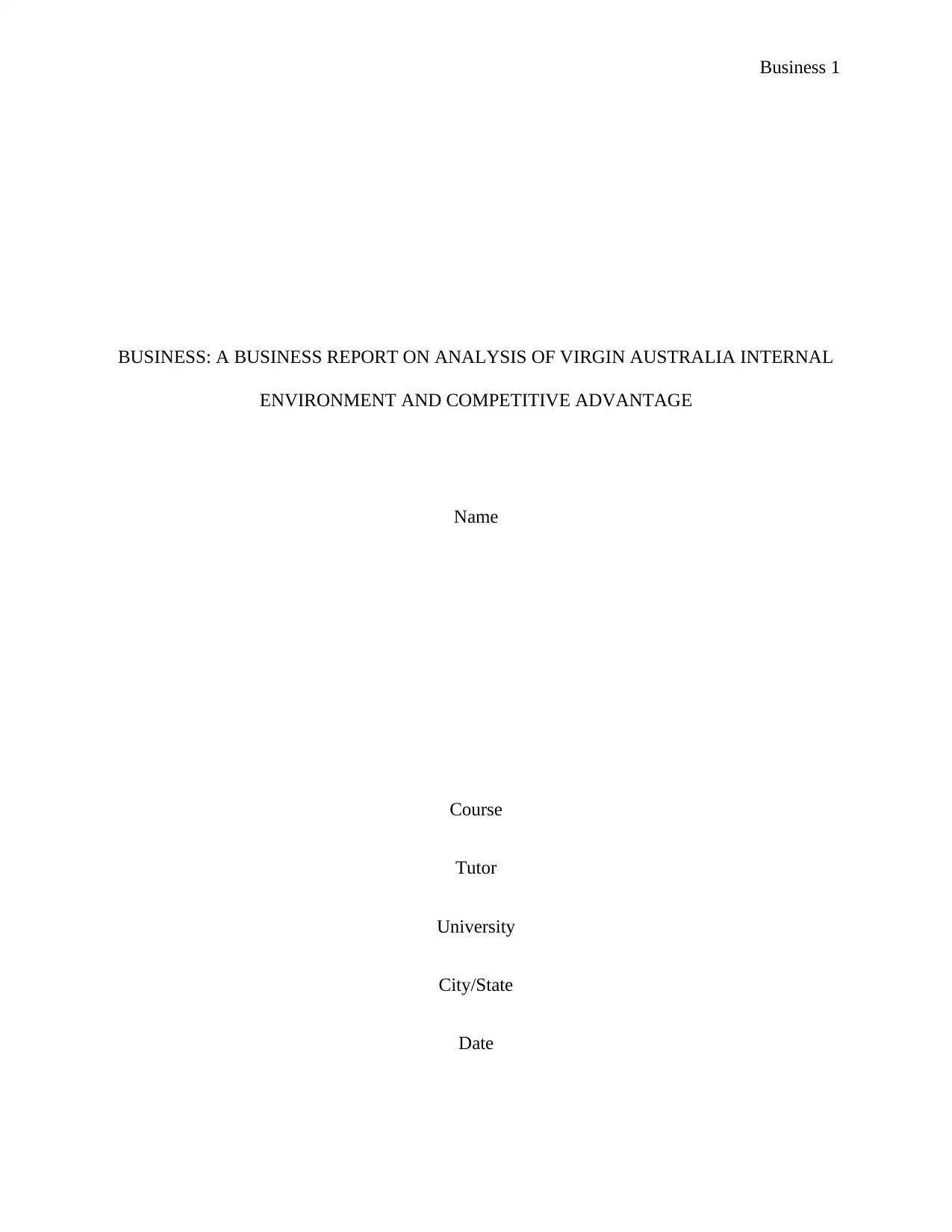
Business 1
BUSINESS: A BUSINESS REPORT ON ANALYSIS OF VIRGIN AUSTRALIA INTERNAL
ENVIRONMENT AND COMPETITIVE ADVANTAGE
Name
Course
Tutor
University
City/State
Date
BUSINESS: A BUSINESS REPORT ON ANALYSIS OF VIRGIN AUSTRALIA INTERNAL
ENVIRONMENT AND COMPETITIVE ADVANTAGE
Name
Course
Tutor
University
City/State
Date
Paraphrase This Document
Need a fresh take? Get an instant paraphrase of this document with our AI Paraphraser
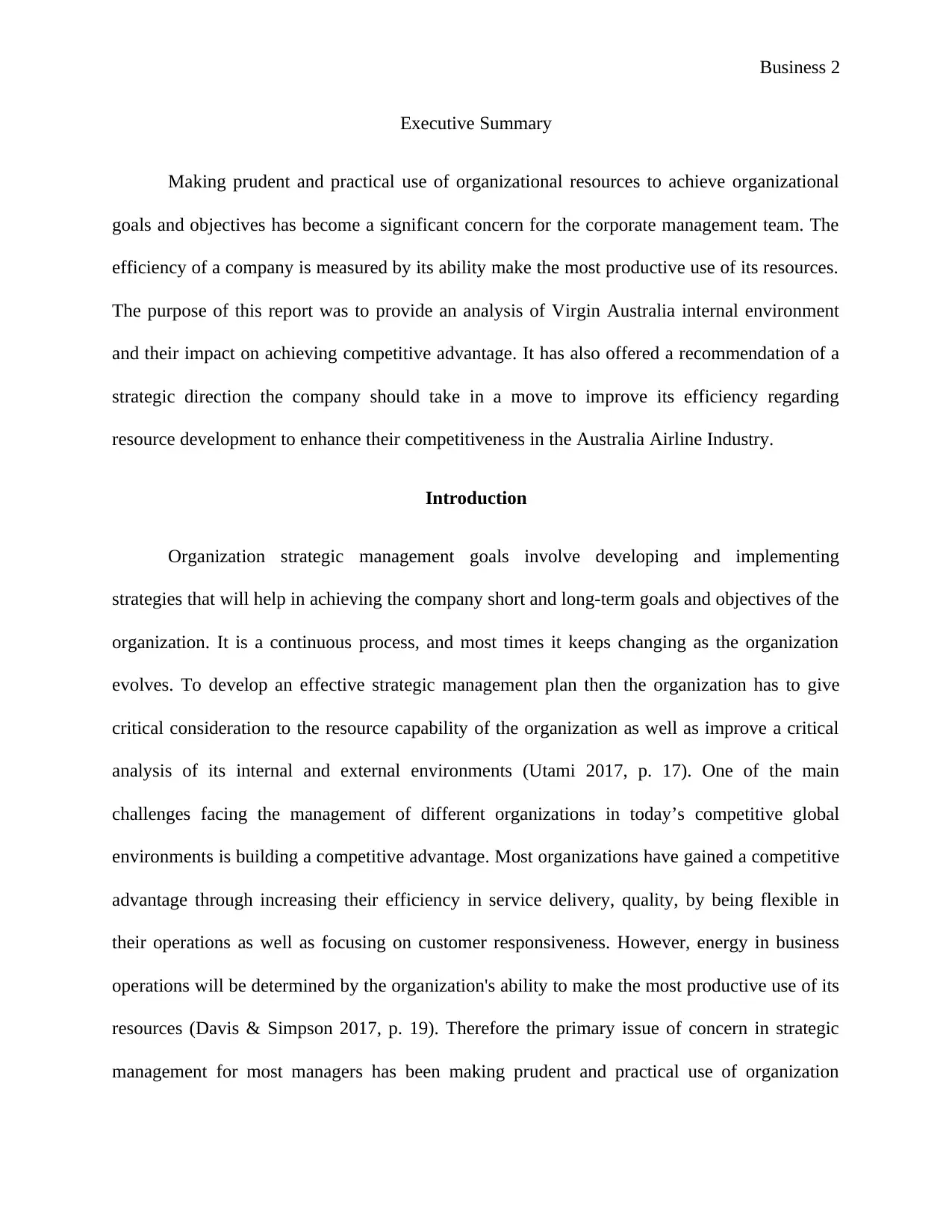
Business 2
Executive Summary
Making prudent and practical use of organizational resources to achieve organizational
goals and objectives has become a significant concern for the corporate management team. The
efficiency of a company is measured by its ability make the most productive use of its resources.
The purpose of this report was to provide an analysis of Virgin Australia internal environment
and their impact on achieving competitive advantage. It has also offered a recommendation of a
strategic direction the company should take in a move to improve its efficiency regarding
resource development to enhance their competitiveness in the Australia Airline Industry.
Introduction
Organization strategic management goals involve developing and implementing
strategies that will help in achieving the company short and long-term goals and objectives of the
organization. It is a continuous process, and most times it keeps changing as the organization
evolves. To develop an effective strategic management plan then the organization has to give
critical consideration to the resource capability of the organization as well as improve a critical
analysis of its internal and external environments (Utami 2017, p. 17). One of the main
challenges facing the management of different organizations in today’s competitive global
environments is building a competitive advantage. Most organizations have gained a competitive
advantage through increasing their efficiency in service delivery, quality, by being flexible in
their operations as well as focusing on customer responsiveness. However, energy in business
operations will be determined by the organization's ability to make the most productive use of its
resources (Davis & Simpson 2017, p. 19). Therefore the primary issue of concern in strategic
management for most managers has been making prudent and practical use of organization
Executive Summary
Making prudent and practical use of organizational resources to achieve organizational
goals and objectives has become a significant concern for the corporate management team. The
efficiency of a company is measured by its ability make the most productive use of its resources.
The purpose of this report was to provide an analysis of Virgin Australia internal environment
and their impact on achieving competitive advantage. It has also offered a recommendation of a
strategic direction the company should take in a move to improve its efficiency regarding
resource development to enhance their competitiveness in the Australia Airline Industry.
Introduction
Organization strategic management goals involve developing and implementing
strategies that will help in achieving the company short and long-term goals and objectives of the
organization. It is a continuous process, and most times it keeps changing as the organization
evolves. To develop an effective strategic management plan then the organization has to give
critical consideration to the resource capability of the organization as well as improve a critical
analysis of its internal and external environments (Utami 2017, p. 17). One of the main
challenges facing the management of different organizations in today’s competitive global
environments is building a competitive advantage. Most organizations have gained a competitive
advantage through increasing their efficiency in service delivery, quality, by being flexible in
their operations as well as focusing on customer responsiveness. However, energy in business
operations will be determined by the organization's ability to make the most productive use of its
resources (Davis & Simpson 2017, p. 19). Therefore the primary issue of concern in strategic
management for most managers has been making prudent and practical use of organization
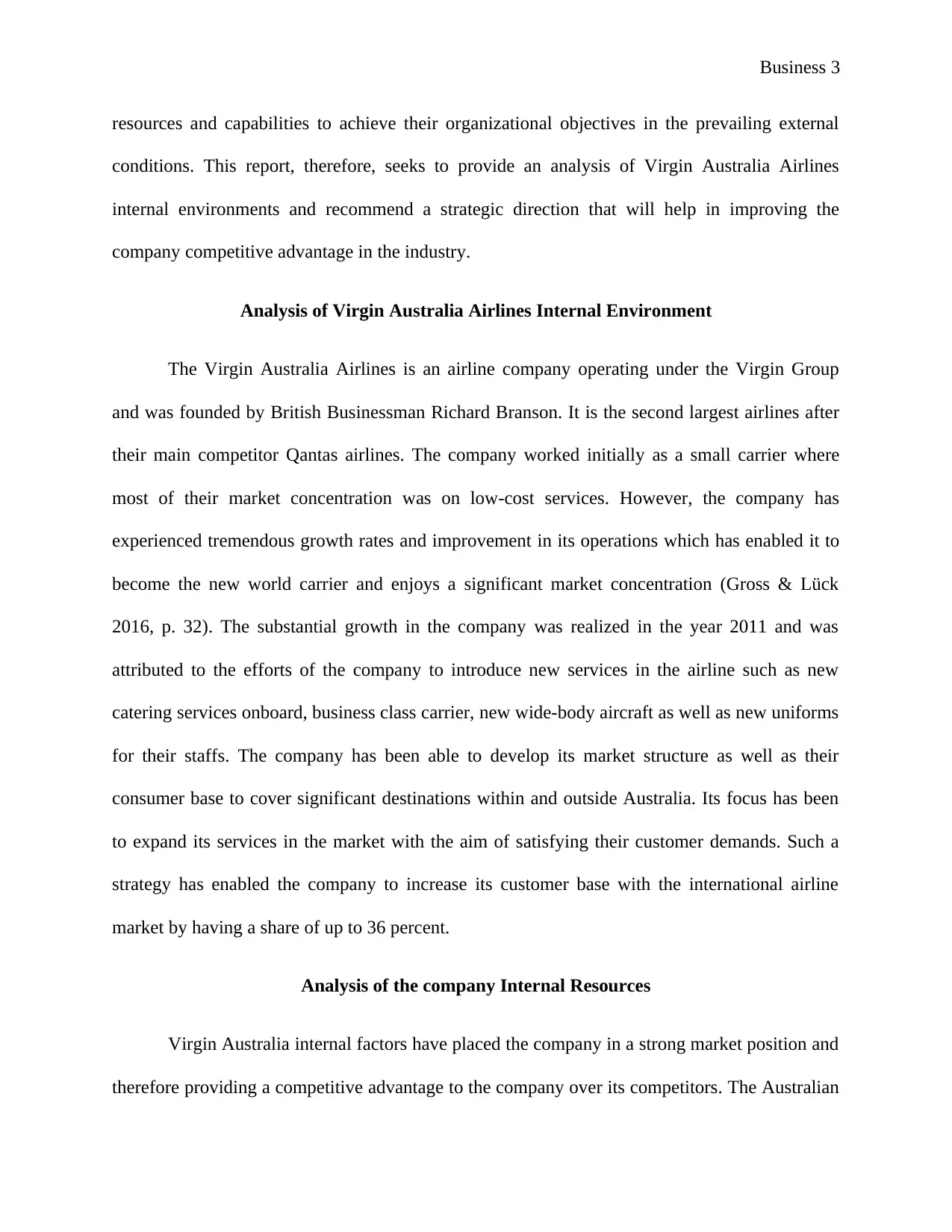
Business 3
resources and capabilities to achieve their organizational objectives in the prevailing external
conditions. This report, therefore, seeks to provide an analysis of Virgin Australia Airlines
internal environments and recommend a strategic direction that will help in improving the
company competitive advantage in the industry.
Analysis of Virgin Australia Airlines Internal Environment
The Virgin Australia Airlines is an airline company operating under the Virgin Group
and was founded by British Businessman Richard Branson. It is the second largest airlines after
their main competitor Qantas airlines. The company worked initially as a small carrier where
most of their market concentration was on low-cost services. However, the company has
experienced tremendous growth rates and improvement in its operations which has enabled it to
become the new world carrier and enjoys a significant market concentration (Gross & Lück
2016, p. 32). The substantial growth in the company was realized in the year 2011 and was
attributed to the efforts of the company to introduce new services in the airline such as new
catering services onboard, business class carrier, new wide-body aircraft as well as new uniforms
for their staffs. The company has been able to develop its market structure as well as their
consumer base to cover significant destinations within and outside Australia. Its focus has been
to expand its services in the market with the aim of satisfying their customer demands. Such a
strategy has enabled the company to increase its customer base with the international airline
market by having a share of up to 36 percent.
Analysis of the company Internal Resources
Virgin Australia internal factors have placed the company in a strong market position and
therefore providing a competitive advantage to the company over its competitors. The Australian
resources and capabilities to achieve their organizational objectives in the prevailing external
conditions. This report, therefore, seeks to provide an analysis of Virgin Australia Airlines
internal environments and recommend a strategic direction that will help in improving the
company competitive advantage in the industry.
Analysis of Virgin Australia Airlines Internal Environment
The Virgin Australia Airlines is an airline company operating under the Virgin Group
and was founded by British Businessman Richard Branson. It is the second largest airlines after
their main competitor Qantas airlines. The company worked initially as a small carrier where
most of their market concentration was on low-cost services. However, the company has
experienced tremendous growth rates and improvement in its operations which has enabled it to
become the new world carrier and enjoys a significant market concentration (Gross & Lück
2016, p. 32). The substantial growth in the company was realized in the year 2011 and was
attributed to the efforts of the company to introduce new services in the airline such as new
catering services onboard, business class carrier, new wide-body aircraft as well as new uniforms
for their staffs. The company has been able to develop its market structure as well as their
consumer base to cover significant destinations within and outside Australia. Its focus has been
to expand its services in the market with the aim of satisfying their customer demands. Such a
strategy has enabled the company to increase its customer base with the international airline
market by having a share of up to 36 percent.
Analysis of the company Internal Resources
Virgin Australia internal factors have placed the company in a strong market position and
therefore providing a competitive advantage to the company over its competitors. The Australian
⊘ This is a preview!⊘
Do you want full access?
Subscribe today to unlock all pages.

Trusted by 1+ million students worldwide
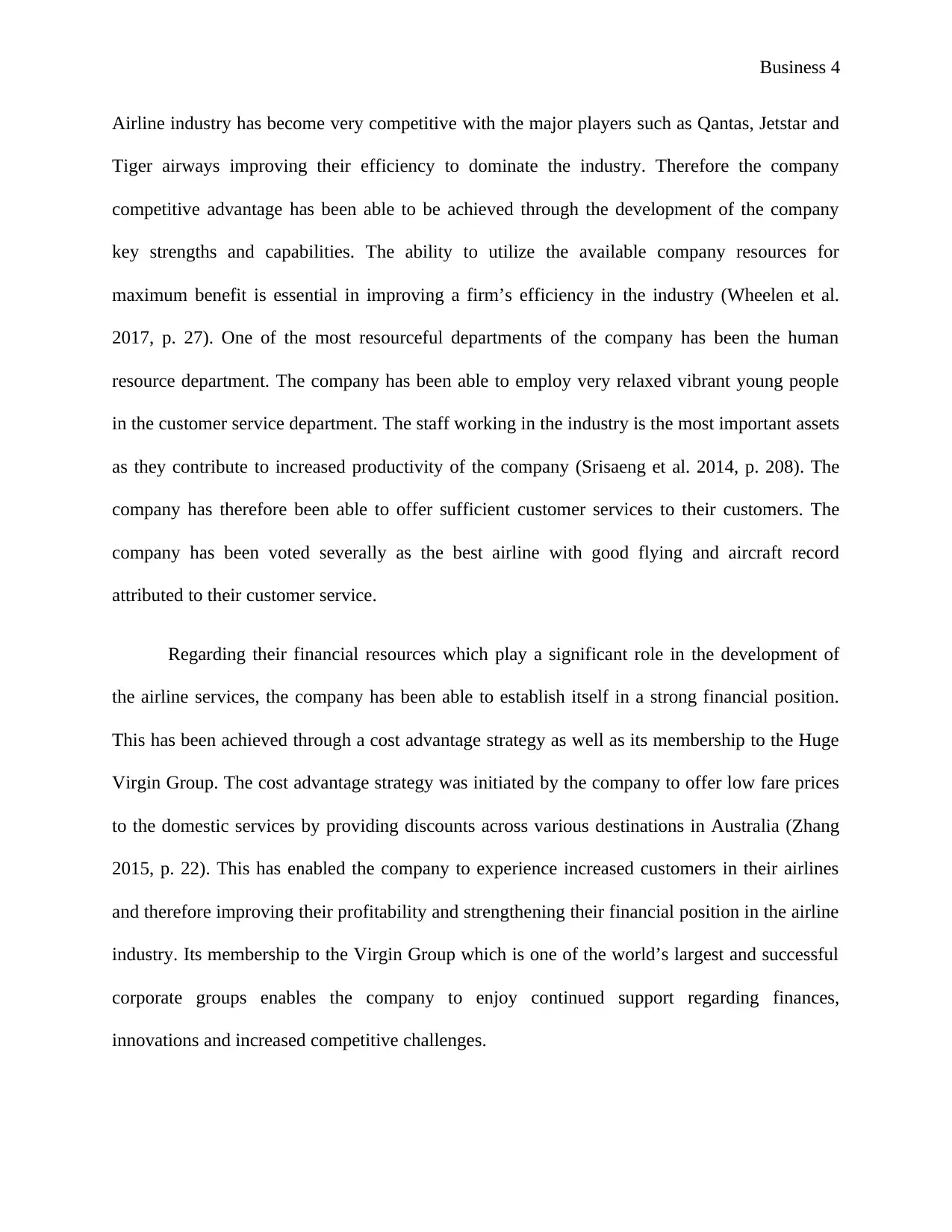
Business 4
Airline industry has become very competitive with the major players such as Qantas, Jetstar and
Tiger airways improving their efficiency to dominate the industry. Therefore the company
competitive advantage has been able to be achieved through the development of the company
key strengths and capabilities. The ability to utilize the available company resources for
maximum benefit is essential in improving a firm’s efficiency in the industry (Wheelen et al.
2017, p. 27). One of the most resourceful departments of the company has been the human
resource department. The company has been able to employ very relaxed vibrant young people
in the customer service department. The staff working in the industry is the most important assets
as they contribute to increased productivity of the company (Srisaeng et al. 2014, p. 208). The
company has therefore been able to offer sufficient customer services to their customers. The
company has been voted severally as the best airline with good flying and aircraft record
attributed to their customer service.
Regarding their financial resources which play a significant role in the development of
the airline services, the company has been able to establish itself in a strong financial position.
This has been achieved through a cost advantage strategy as well as its membership to the Huge
Virgin Group. The cost advantage strategy was initiated by the company to offer low fare prices
to the domestic services by providing discounts across various destinations in Australia (Zhang
2015, p. 22). This has enabled the company to experience increased customers in their airlines
and therefore improving their profitability and strengthening their financial position in the airline
industry. Its membership to the Virgin Group which is one of the world’s largest and successful
corporate groups enables the company to enjoy continued support regarding finances,
innovations and increased competitive challenges.
Airline industry has become very competitive with the major players such as Qantas, Jetstar and
Tiger airways improving their efficiency to dominate the industry. Therefore the company
competitive advantage has been able to be achieved through the development of the company
key strengths and capabilities. The ability to utilize the available company resources for
maximum benefit is essential in improving a firm’s efficiency in the industry (Wheelen et al.
2017, p. 27). One of the most resourceful departments of the company has been the human
resource department. The company has been able to employ very relaxed vibrant young people
in the customer service department. The staff working in the industry is the most important assets
as they contribute to increased productivity of the company (Srisaeng et al. 2014, p. 208). The
company has therefore been able to offer sufficient customer services to their customers. The
company has been voted severally as the best airline with good flying and aircraft record
attributed to their customer service.
Regarding their financial resources which play a significant role in the development of
the airline services, the company has been able to establish itself in a strong financial position.
This has been achieved through a cost advantage strategy as well as its membership to the Huge
Virgin Group. The cost advantage strategy was initiated by the company to offer low fare prices
to the domestic services by providing discounts across various destinations in Australia (Zhang
2015, p. 22). This has enabled the company to experience increased customers in their airlines
and therefore improving their profitability and strengthening their financial position in the airline
industry. Its membership to the Virgin Group which is one of the world’s largest and successful
corporate groups enables the company to enjoy continued support regarding finances,
innovations and increased competitive challenges.
Paraphrase This Document
Need a fresh take? Get an instant paraphrase of this document with our AI Paraphraser
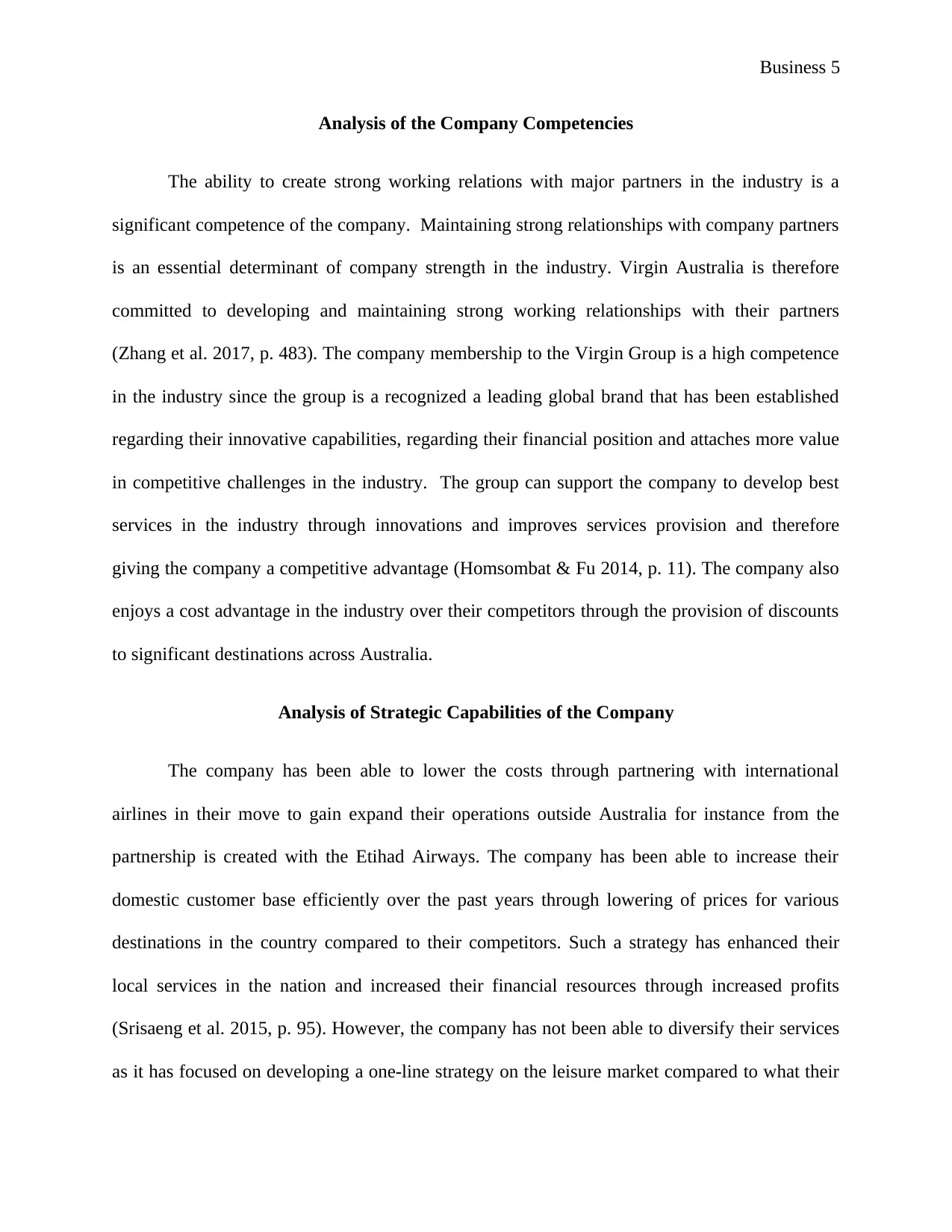
Business 5
Analysis of the Company Competencies
The ability to create strong working relations with major partners in the industry is a
significant competence of the company. Maintaining strong relationships with company partners
is an essential determinant of company strength in the industry. Virgin Australia is therefore
committed to developing and maintaining strong working relationships with their partners
(Zhang et al. 2017, p. 483). The company membership to the Virgin Group is a high competence
in the industry since the group is a recognized a leading global brand that has been established
regarding their innovative capabilities, regarding their financial position and attaches more value
in competitive challenges in the industry. The group can support the company to develop best
services in the industry through innovations and improves services provision and therefore
giving the company a competitive advantage (Homsombat & Fu 2014, p. 11). The company also
enjoys a cost advantage in the industry over their competitors through the provision of discounts
to significant destinations across Australia.
Analysis of Strategic Capabilities of the Company
The company has been able to lower the costs through partnering with international
airlines in their move to gain expand their operations outside Australia for instance from the
partnership is created with the Etihad Airways. The company has been able to increase their
domestic customer base efficiently over the past years through lowering of prices for various
destinations in the country compared to their competitors. Such a strategy has enhanced their
local services in the nation and increased their financial resources through increased profits
(Srisaeng et al. 2015, p. 95). However, the company has not been able to diversify their services
as it has focused on developing a one-line strategy on the leisure market compared to what their
Analysis of the Company Competencies
The ability to create strong working relations with major partners in the industry is a
significant competence of the company. Maintaining strong relationships with company partners
is an essential determinant of company strength in the industry. Virgin Australia is therefore
committed to developing and maintaining strong working relationships with their partners
(Zhang et al. 2017, p. 483). The company membership to the Virgin Group is a high competence
in the industry since the group is a recognized a leading global brand that has been established
regarding their innovative capabilities, regarding their financial position and attaches more value
in competitive challenges in the industry. The group can support the company to develop best
services in the industry through innovations and improves services provision and therefore
giving the company a competitive advantage (Homsombat & Fu 2014, p. 11). The company also
enjoys a cost advantage in the industry over their competitors through the provision of discounts
to significant destinations across Australia.
Analysis of Strategic Capabilities of the Company
The company has been able to lower the costs through partnering with international
airlines in their move to gain expand their operations outside Australia for instance from the
partnership is created with the Etihad Airways. The company has been able to increase their
domestic customer base efficiently over the past years through lowering of prices for various
destinations in the country compared to their competitors. Such a strategy has enhanced their
local services in the nation and increased their financial resources through increased profits
(Srisaeng et al. 2015, p. 95). However, the company has not been able to diversify their services
as it has focused on developing a one-line strategy on the leisure market compared to what their
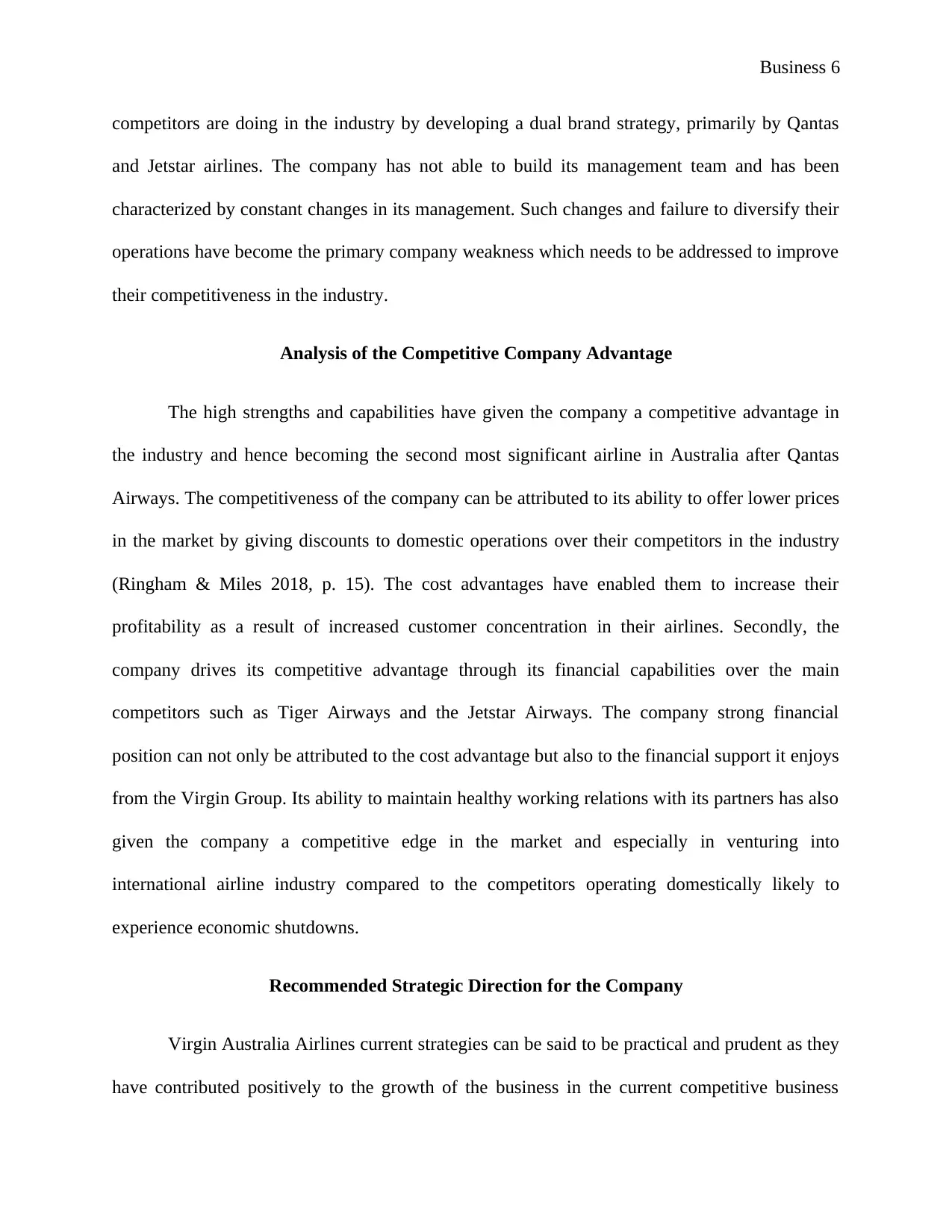
Business 6
competitors are doing in the industry by developing a dual brand strategy, primarily by Qantas
and Jetstar airlines. The company has not able to build its management team and has been
characterized by constant changes in its management. Such changes and failure to diversify their
operations have become the primary company weakness which needs to be addressed to improve
their competitiveness in the industry.
Analysis of the Competitive Company Advantage
The high strengths and capabilities have given the company a competitive advantage in
the industry and hence becoming the second most significant airline in Australia after Qantas
Airways. The competitiveness of the company can be attributed to its ability to offer lower prices
in the market by giving discounts to domestic operations over their competitors in the industry
(Ringham & Miles 2018, p. 15). The cost advantages have enabled them to increase their
profitability as a result of increased customer concentration in their airlines. Secondly, the
company drives its competitive advantage through its financial capabilities over the main
competitors such as Tiger Airways and the Jetstar Airways. The company strong financial
position can not only be attributed to the cost advantage but also to the financial support it enjoys
from the Virgin Group. Its ability to maintain healthy working relations with its partners has also
given the company a competitive edge in the market and especially in venturing into
international airline industry compared to the competitors operating domestically likely to
experience economic shutdowns.
Recommended Strategic Direction for the Company
Virgin Australia Airlines current strategies can be said to be practical and prudent as they
have contributed positively to the growth of the business in the current competitive business
competitors are doing in the industry by developing a dual brand strategy, primarily by Qantas
and Jetstar airlines. The company has not able to build its management team and has been
characterized by constant changes in its management. Such changes and failure to diversify their
operations have become the primary company weakness which needs to be addressed to improve
their competitiveness in the industry.
Analysis of the Competitive Company Advantage
The high strengths and capabilities have given the company a competitive advantage in
the industry and hence becoming the second most significant airline in Australia after Qantas
Airways. The competitiveness of the company can be attributed to its ability to offer lower prices
in the market by giving discounts to domestic operations over their competitors in the industry
(Ringham & Miles 2018, p. 15). The cost advantages have enabled them to increase their
profitability as a result of increased customer concentration in their airlines. Secondly, the
company drives its competitive advantage through its financial capabilities over the main
competitors such as Tiger Airways and the Jetstar Airways. The company strong financial
position can not only be attributed to the cost advantage but also to the financial support it enjoys
from the Virgin Group. Its ability to maintain healthy working relations with its partners has also
given the company a competitive edge in the market and especially in venturing into
international airline industry compared to the competitors operating domestically likely to
experience economic shutdowns.
Recommended Strategic Direction for the Company
Virgin Australia Airlines current strategies can be said to be practical and prudent as they
have contributed positively to the growth of the business in the current competitive business
⊘ This is a preview!⊘
Do you want full access?
Subscribe today to unlock all pages.

Trusted by 1+ million students worldwide
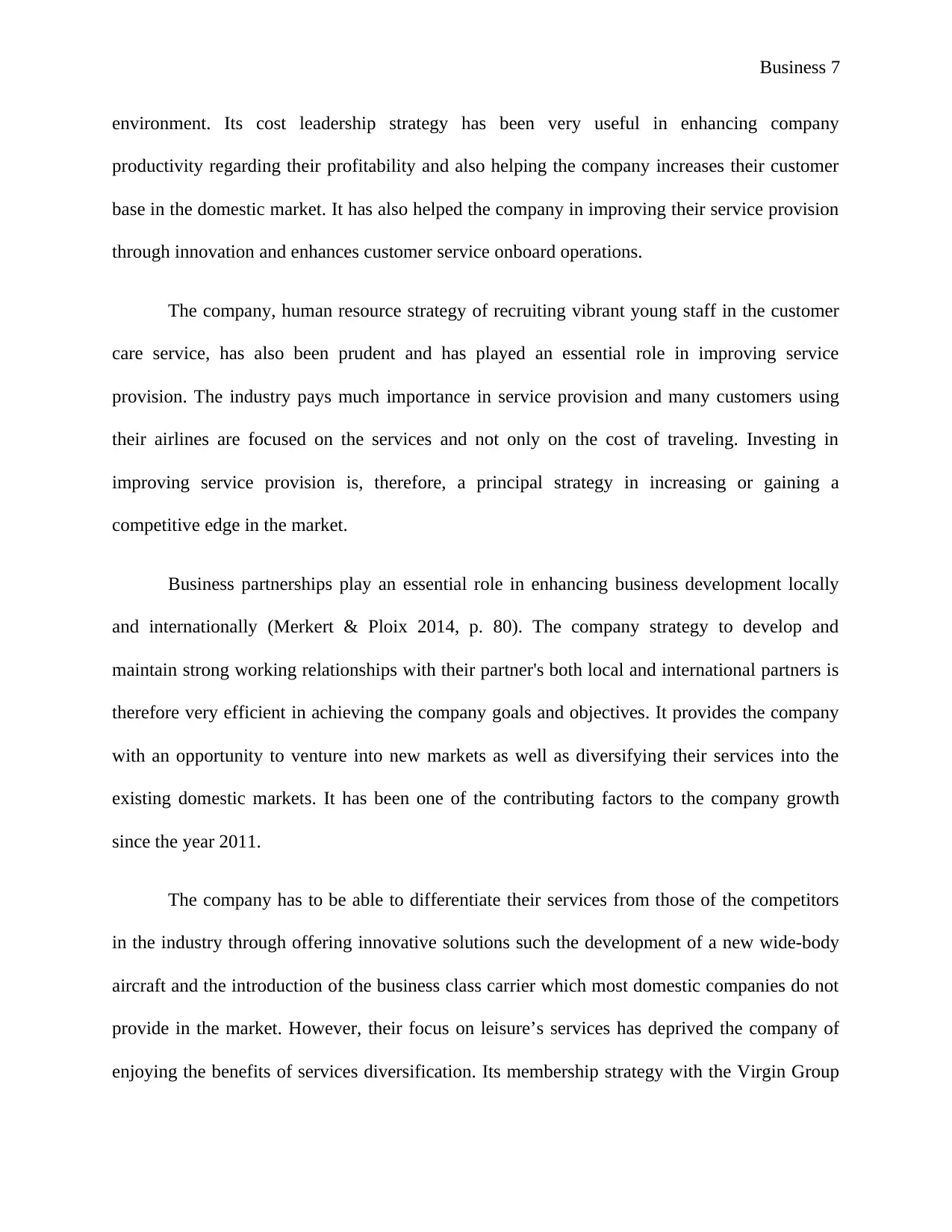
Business 7
environment. Its cost leadership strategy has been very useful in enhancing company
productivity regarding their profitability and also helping the company increases their customer
base in the domestic market. It has also helped the company in improving their service provision
through innovation and enhances customer service onboard operations.
The company, human resource strategy of recruiting vibrant young staff in the customer
care service, has also been prudent and has played an essential role in improving service
provision. The industry pays much importance in service provision and many customers using
their airlines are focused on the services and not only on the cost of traveling. Investing in
improving service provision is, therefore, a principal strategy in increasing or gaining a
competitive edge in the market.
Business partnerships play an essential role in enhancing business development locally
and internationally (Merkert & Ploix 2014, p. 80). The company strategy to develop and
maintain strong working relationships with their partner's both local and international partners is
therefore very efficient in achieving the company goals and objectives. It provides the company
with an opportunity to venture into new markets as well as diversifying their services into the
existing domestic markets. It has been one of the contributing factors to the company growth
since the year 2011.
The company has to be able to differentiate their services from those of the competitors
in the industry through offering innovative solutions such the development of a new wide-body
aircraft and the introduction of the business class carrier which most domestic companies do not
provide in the market. However, their focus on leisure’s services has deprived the company of
enjoying the benefits of services diversification. Its membership strategy with the Virgin Group
environment. Its cost leadership strategy has been very useful in enhancing company
productivity regarding their profitability and also helping the company increases their customer
base in the domestic market. It has also helped the company in improving their service provision
through innovation and enhances customer service onboard operations.
The company, human resource strategy of recruiting vibrant young staff in the customer
care service, has also been prudent and has played an essential role in improving service
provision. The industry pays much importance in service provision and many customers using
their airlines are focused on the services and not only on the cost of traveling. Investing in
improving service provision is, therefore, a principal strategy in increasing or gaining a
competitive edge in the market.
Business partnerships play an essential role in enhancing business development locally
and internationally (Merkert & Ploix 2014, p. 80). The company strategy to develop and
maintain strong working relationships with their partner's both local and international partners is
therefore very efficient in achieving the company goals and objectives. It provides the company
with an opportunity to venture into new markets as well as diversifying their services into the
existing domestic markets. It has been one of the contributing factors to the company growth
since the year 2011.
The company has to be able to differentiate their services from those of the competitors
in the industry through offering innovative solutions such the development of a new wide-body
aircraft and the introduction of the business class carrier which most domestic companies do not
provide in the market. However, their focus on leisure’s services has deprived the company of
enjoying the benefits of services diversification. Its membership strategy with the Virgin Group
Paraphrase This Document
Need a fresh take? Get an instant paraphrase of this document with our AI Paraphraser
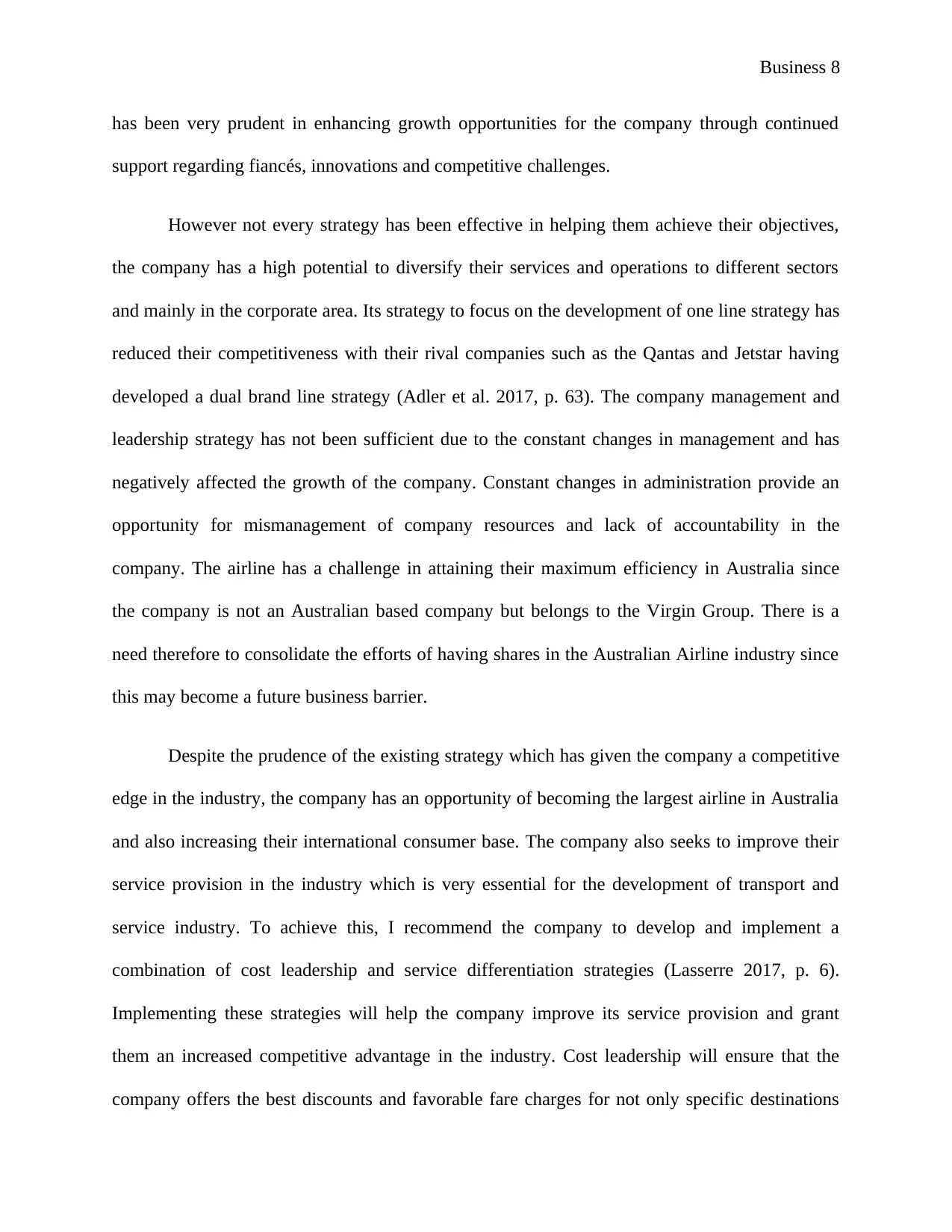
Business 8
has been very prudent in enhancing growth opportunities for the company through continued
support regarding fiancés, innovations and competitive challenges.
However not every strategy has been effective in helping them achieve their objectives,
the company has a high potential to diversify their services and operations to different sectors
and mainly in the corporate area. Its strategy to focus on the development of one line strategy has
reduced their competitiveness with their rival companies such as the Qantas and Jetstar having
developed a dual brand line strategy (Adler et al. 2017, p. 63). The company management and
leadership strategy has not been sufficient due to the constant changes in management and has
negatively affected the growth of the company. Constant changes in administration provide an
opportunity for mismanagement of company resources and lack of accountability in the
company. The airline has a challenge in attaining their maximum efficiency in Australia since
the company is not an Australian based company but belongs to the Virgin Group. There is a
need therefore to consolidate the efforts of having shares in the Australian Airline industry since
this may become a future business barrier.
Despite the prudence of the existing strategy which has given the company a competitive
edge in the industry, the company has an opportunity of becoming the largest airline in Australia
and also increasing their international consumer base. The company also seeks to improve their
service provision in the industry which is very essential for the development of transport and
service industry. To achieve this, I recommend the company to develop and implement a
combination of cost leadership and service differentiation strategies (Lasserre 2017, p. 6).
Implementing these strategies will help the company improve its service provision and grant
them an increased competitive advantage in the industry. Cost leadership will ensure that the
company offers the best discounts and favorable fare charges for not only specific destinations
has been very prudent in enhancing growth opportunities for the company through continued
support regarding fiancés, innovations and competitive challenges.
However not every strategy has been effective in helping them achieve their objectives,
the company has a high potential to diversify their services and operations to different sectors
and mainly in the corporate area. Its strategy to focus on the development of one line strategy has
reduced their competitiveness with their rival companies such as the Qantas and Jetstar having
developed a dual brand line strategy (Adler et al. 2017, p. 63). The company management and
leadership strategy has not been sufficient due to the constant changes in management and has
negatively affected the growth of the company. Constant changes in administration provide an
opportunity for mismanagement of company resources and lack of accountability in the
company. The airline has a challenge in attaining their maximum efficiency in Australia since
the company is not an Australian based company but belongs to the Virgin Group. There is a
need therefore to consolidate the efforts of having shares in the Australian Airline industry since
this may become a future business barrier.
Despite the prudence of the existing strategy which has given the company a competitive
edge in the industry, the company has an opportunity of becoming the largest airline in Australia
and also increasing their international consumer base. The company also seeks to improve their
service provision in the industry which is very essential for the development of transport and
service industry. To achieve this, I recommend the company to develop and implement a
combination of cost leadership and service differentiation strategies (Lasserre 2017, p. 6).
Implementing these strategies will help the company improve its service provision and grant
them an increased competitive advantage in the industry. Cost leadership will ensure that the
company offers the best discounts and favorable fare charges for not only specific destinations
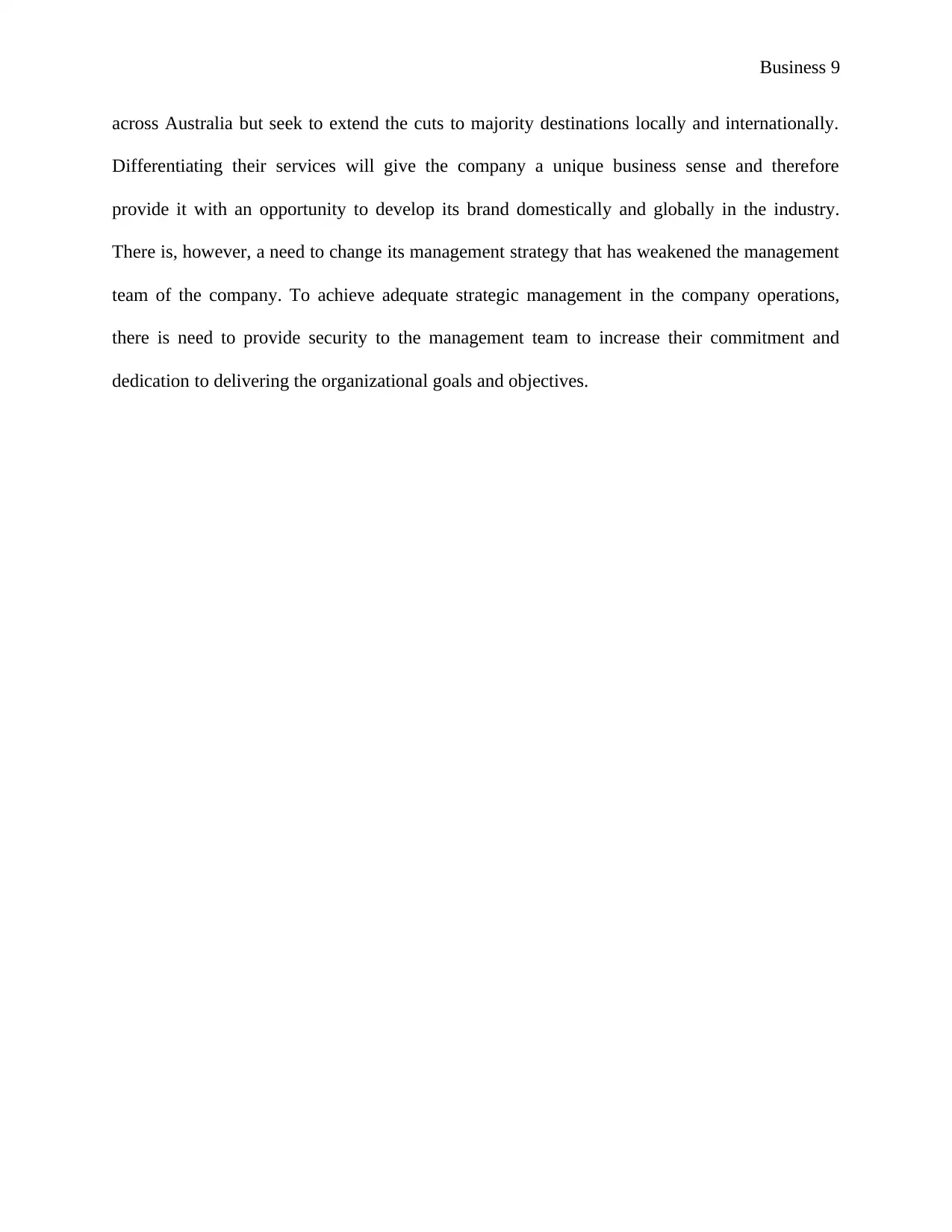
Business 9
across Australia but seek to extend the cuts to majority destinations locally and internationally.
Differentiating their services will give the company a unique business sense and therefore
provide it with an opportunity to develop its brand domestically and globally in the industry.
There is, however, a need to change its management strategy that has weakened the management
team of the company. To achieve adequate strategic management in the company operations,
there is need to provide security to the management team to increase their commitment and
dedication to delivering the organizational goals and objectives.
across Australia but seek to extend the cuts to majority destinations locally and internationally.
Differentiating their services will give the company a unique business sense and therefore
provide it with an opportunity to develop its brand domestically and globally in the industry.
There is, however, a need to change its management strategy that has weakened the management
team of the company. To achieve adequate strategic management in the company operations,
there is need to provide security to the management team to increase their commitment and
dedication to delivering the organizational goals and objectives.
⊘ This is a preview!⊘
Do you want full access?
Subscribe today to unlock all pages.

Trusted by 1+ million students worldwide
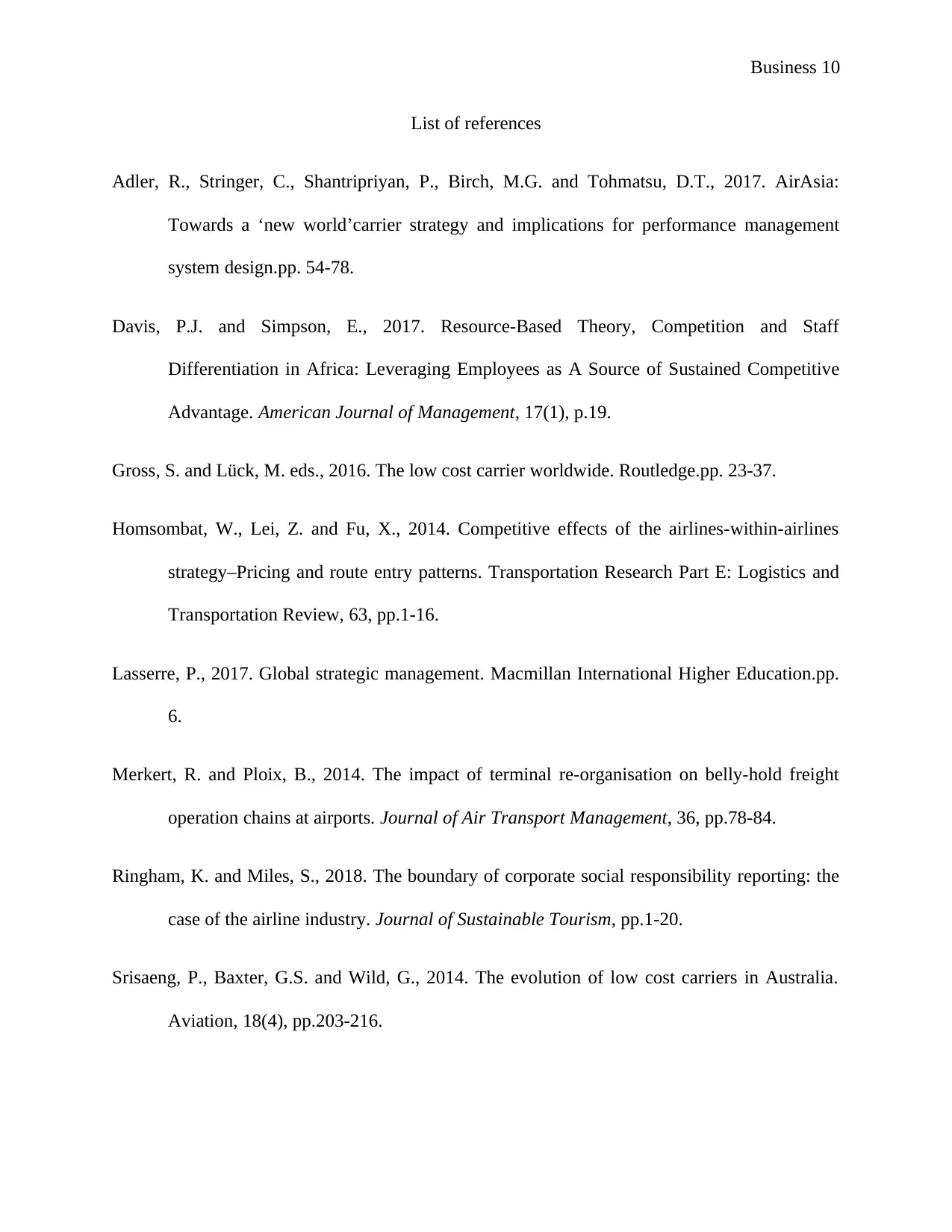
Business 10
List of references
Adler, R., Stringer, C., Shantripriyan, P., Birch, M.G. and Tohmatsu, D.T., 2017. AirAsia:
Towards a ‘new world’carrier strategy and implications for performance management
system design.pp. 54-78.
Davis, P.J. and Simpson, E., 2017. Resource-Based Theory, Competition and Staff
Differentiation in Africa: Leveraging Employees as A Source of Sustained Competitive
Advantage. American Journal of Management, 17(1), p.19.
Gross, S. and Lück, M. eds., 2016. The low cost carrier worldwide. Routledge.pp. 23-37.
Homsombat, W., Lei, Z. and Fu, X., 2014. Competitive effects of the airlines-within-airlines
strategy–Pricing and route entry patterns. Transportation Research Part E: Logistics and
Transportation Review, 63, pp.1-16.
Lasserre, P., 2017. Global strategic management. Macmillan International Higher Education.pp.
6.
Merkert, R. and Ploix, B., 2014. The impact of terminal re-organisation on belly-hold freight
operation chains at airports. Journal of Air Transport Management, 36, pp.78-84.
Ringham, K. and Miles, S., 2018. The boundary of corporate social responsibility reporting: the
case of the airline industry. Journal of Sustainable Tourism, pp.1-20.
Srisaeng, P., Baxter, G.S. and Wild, G., 2014. The evolution of low cost carriers in Australia.
Aviation, 18(4), pp.203-216.
List of references
Adler, R., Stringer, C., Shantripriyan, P., Birch, M.G. and Tohmatsu, D.T., 2017. AirAsia:
Towards a ‘new world’carrier strategy and implications for performance management
system design.pp. 54-78.
Davis, P.J. and Simpson, E., 2017. Resource-Based Theory, Competition and Staff
Differentiation in Africa: Leveraging Employees as A Source of Sustained Competitive
Advantage. American Journal of Management, 17(1), p.19.
Gross, S. and Lück, M. eds., 2016. The low cost carrier worldwide. Routledge.pp. 23-37.
Homsombat, W., Lei, Z. and Fu, X., 2014. Competitive effects of the airlines-within-airlines
strategy–Pricing and route entry patterns. Transportation Research Part E: Logistics and
Transportation Review, 63, pp.1-16.
Lasserre, P., 2017. Global strategic management. Macmillan International Higher Education.pp.
6.
Merkert, R. and Ploix, B., 2014. The impact of terminal re-organisation on belly-hold freight
operation chains at airports. Journal of Air Transport Management, 36, pp.78-84.
Ringham, K. and Miles, S., 2018. The boundary of corporate social responsibility reporting: the
case of the airline industry. Journal of Sustainable Tourism, pp.1-20.
Srisaeng, P., Baxter, G.S. and Wild, G., 2014. The evolution of low cost carriers in Australia.
Aviation, 18(4), pp.203-216.
Paraphrase This Document
Need a fresh take? Get an instant paraphrase of this document with our AI Paraphraser
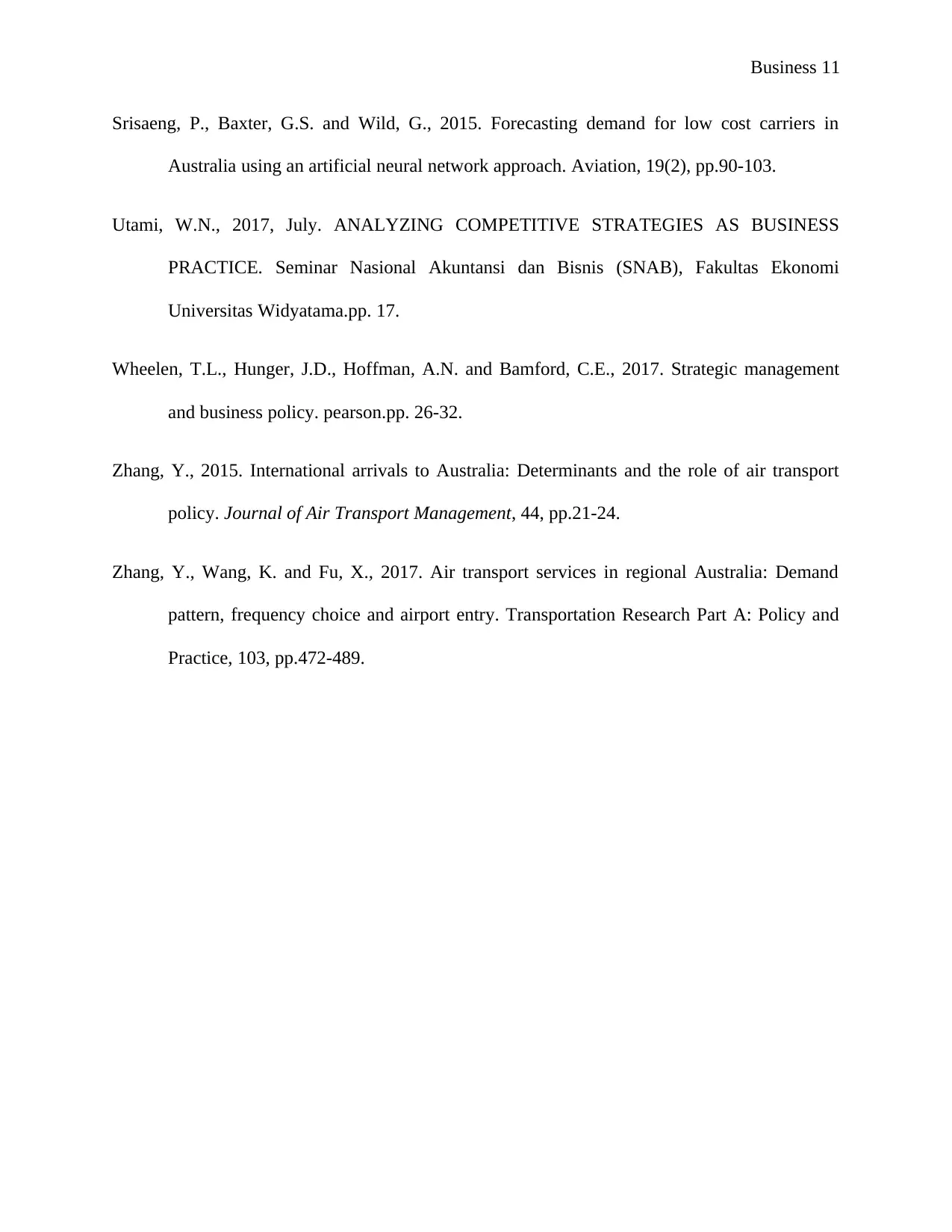
Business 11
Srisaeng, P., Baxter, G.S. and Wild, G., 2015. Forecasting demand for low cost carriers in
Australia using an artificial neural network approach. Aviation, 19(2), pp.90-103.
Utami, W.N., 2017, July. ANALYZING COMPETITIVE STRATEGIES AS BUSINESS
PRACTICE. Seminar Nasional Akuntansi dan Bisnis (SNAB), Fakultas Ekonomi
Universitas Widyatama.pp. 17.
Wheelen, T.L., Hunger, J.D., Hoffman, A.N. and Bamford, C.E., 2017. Strategic management
and business policy. pearson.pp. 26-32.
Zhang, Y., 2015. International arrivals to Australia: Determinants and the role of air transport
policy. Journal of Air Transport Management, 44, pp.21-24.
Zhang, Y., Wang, K. and Fu, X., 2017. Air transport services in regional Australia: Demand
pattern, frequency choice and airport entry. Transportation Research Part A: Policy and
Practice, 103, pp.472-489.
Srisaeng, P., Baxter, G.S. and Wild, G., 2015. Forecasting demand for low cost carriers in
Australia using an artificial neural network approach. Aviation, 19(2), pp.90-103.
Utami, W.N., 2017, July. ANALYZING COMPETITIVE STRATEGIES AS BUSINESS
PRACTICE. Seminar Nasional Akuntansi dan Bisnis (SNAB), Fakultas Ekonomi
Universitas Widyatama.pp. 17.
Wheelen, T.L., Hunger, J.D., Hoffman, A.N. and Bamford, C.E., 2017. Strategic management
and business policy. pearson.pp. 26-32.
Zhang, Y., 2015. International arrivals to Australia: Determinants and the role of air transport
policy. Journal of Air Transport Management, 44, pp.21-24.
Zhang, Y., Wang, K. and Fu, X., 2017. Air transport services in regional Australia: Demand
pattern, frequency choice and airport entry. Transportation Research Part A: Policy and
Practice, 103, pp.472-489.
1 out of 11
Related Documents
Your All-in-One AI-Powered Toolkit for Academic Success.
+13062052269
info@desklib.com
Available 24*7 on WhatsApp / Email
![[object Object]](/_next/static/media/star-bottom.7253800d.svg)
Unlock your academic potential
Copyright © 2020–2025 A2Z Services. All Rights Reserved. Developed and managed by ZUCOL.





